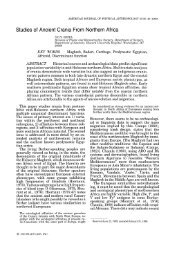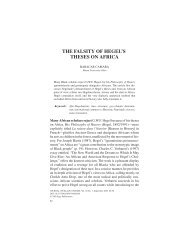Dutch Slavery and Slave Trade in the Indian Ocean
Dutch Slavery and Slave Trade in the Indian Ocean
Dutch Slavery and Slave Trade in the Indian Ocean
You also want an ePaper? Increase the reach of your titles
YUMPU automatically turns print PDFs into web optimized ePapers that Google loves.
160 journal of world history, june 2003<br />
of great dem<strong>and</strong> or for special projects, though normally “pieces” of<br />
slaves were stowed as supplementary cargo on board <strong>Dutch</strong> East India<br />
ships along with o<strong>the</strong>r commodities. Company officials as private <strong>in</strong>dividuals<br />
also engaged <strong>in</strong> <strong>the</strong> legal <strong>and</strong> illegal slave trade. Foreign slavers<br />
would occasionally sell some of <strong>the</strong>ir forced labor when call<strong>in</strong>g at one<br />
of <strong>the</strong> VOC ports en route to <strong>the</strong>ir ultimate dest<strong>in</strong>ation. Free burgher<br />
<strong>and</strong> Asian merchants (rulers, nobility, <strong>and</strong> commoners) rout<strong>in</strong>ely carried<br />
slaves throughout <strong>the</strong> <strong>Indian</strong> <strong>Ocean</strong> as part of <strong>the</strong> so-called country<br />
or <strong>in</strong>tra-Asian trade.<br />
<strong>Slave</strong> Occupations<br />
<strong>Slave</strong>s were general laborers <strong>and</strong> used <strong>in</strong> a wide variety of occupations<br />
<strong>in</strong> <strong>the</strong> <strong>Dutch</strong> slave societies across <strong>the</strong> <strong>Indian</strong> <strong>Ocean</strong> bas<strong>in</strong>. Specialization<br />
among private <strong>and</strong> company slaves, however, occurred <strong>in</strong> accordance<br />
with <strong>the</strong> size of <strong>the</strong> <strong>in</strong>dividual slave household <strong>and</strong> <strong>the</strong> particular<br />
position <strong>the</strong> settlement occupied with<strong>in</strong> <strong>the</strong> company’s overall trade<br />
network. The majority of slaves acted as domestic servants <strong>in</strong> small or<br />
large slave households of company officials, free burghers, <strong>and</strong> Asian<br />
subjects <strong>in</strong> areas under <strong>Dutch</strong> jurisdiction. They served as cooks, lamplighters,<br />
houseboys, housemaids, concub<strong>in</strong>es, seamstresses, bread bakers,<br />
tea makers, coachmen, musicians, masseuses, honor guards, valets,<br />
<strong>and</strong> so forth. 71 They performed menial labor as coolies <strong>in</strong> <strong>the</strong> construction<br />
of fortifications, build<strong>in</strong>gs, roads, canals, <strong>and</strong> trenches, <strong>and</strong> as<br />
porters <strong>and</strong> stevedores <strong>in</strong> <strong>the</strong> ports <strong>and</strong> warehouses.<br />
In agriculture, slaves grew food crops (rice, wheat, potatoes, <strong>and</strong><br />
vegetables), cash crops (pepper, nutmeg <strong>and</strong> mace, cloves, sugar, cotton,<br />
tobacco, <strong>and</strong> grapes), <strong>and</strong> herded cattle <strong>and</strong> sheep. In m<strong>in</strong><strong>in</strong>g,<br />
slaves dug for gold, t<strong>in</strong>, <strong>and</strong> o<strong>the</strong>r m<strong>in</strong>erals, <strong>and</strong> broke coral stone for<br />
<strong>the</strong> burn<strong>in</strong>g of lime. They served as fishermen, sailors, <strong>and</strong> country<br />
traders <strong>in</strong> <strong>the</strong> <strong>in</strong>tra-Asiatic trade. In manufactur<strong>in</strong>g, slaves labored <strong>in</strong><br />
artisan workshops as carpenters, furniture makers, coopers, tailors,<br />
cobblers, gold-, silver-, <strong>and</strong> blacksmiths, <strong>and</strong> numerous o<strong>the</strong>r artisanal<br />
occupations. They worked <strong>in</strong> gunpowder mills, sulfur <strong>and</strong> saltpeter<br />
ref<strong>in</strong>eries, arak distilleries, sawmills, shipyards, <strong>and</strong> sugar mills. In <strong>the</strong><br />
service sector, <strong>the</strong>y were active <strong>in</strong> retail, (lower) adm<strong>in</strong>istrative functions,<br />
medical professions (nurses, midwives, etc.), <strong>and</strong> so forth. Polit-<br />
71 De Haan, Oud Batavia I, pp. 458–60. For a good example, see Valentijn, Oud- en<br />
Nieuw Oost-Indiën II, pp. 369–70.




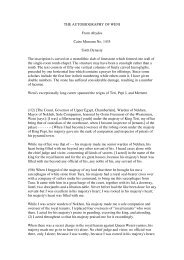
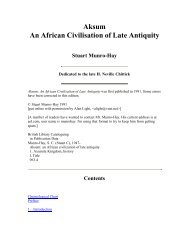
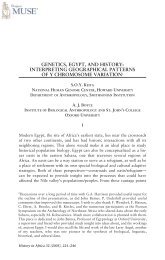

![The Negro trail blazers of California [microform] : a ... - Homestead](https://img.yumpu.com/32436613/1/174x260/the-negro-trail-blazers-of-california-microform-a-homestead.jpg?quality=85)

